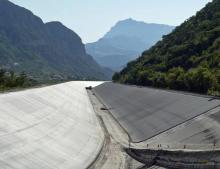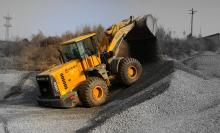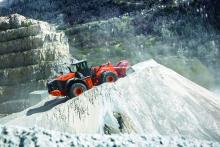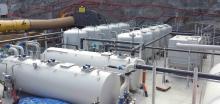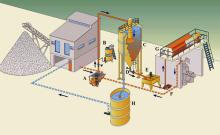
One of the world’s largest infrastructure projects will require millions, if not billions, of tonnes of concrete.
In China, a variety of quarries and plants are producing the aggregates and cement required to supply concrete for the South-North water transfer scheme, which was started in 2002.
After completion, around 45 billion m³ of water will be diverted annually from the Yangtze River in southern China to the Yellow River Basin in arid northern China through the new canals running for several thousands of kilometres.
As part of the ambitious canal constructions, German company MOBA’s excavator system Xsite LINK is in use on the several billion m³ of earth to be moved.
By 2012 some US$27 billion (€20 billion) had been spent; 11 billion m³of earth moved, and 22 million m³ of concrete laid.
The construction project will include the building of new canals in three routes, with the middle route being over 1,200km long. It is the most important route and also the most difficult to build, since in addition to raising a dam, rivers have to be crossed and different types of rocks and soil exist here.
The government plans to complete the Eastern and Central Routes by 2013-14 and the middle Western Route by 2050.
Climate change, water pollution, and frequent droughts are said to be exerting huge pressures on major northern cities such as Beijing and Tianjin.
The construction companies involved in the project, Sinohydro Bureau 11 and Military Police Hydroelectricity, are relying on technical support for the challenging earthworks and have equipped their excavators with the MOBA Xsite LINK excavator system, which makes the earthwork visible and measurable.
Accurate preparatory work is particularly important under these difficult conditions so that the water will be able flow through the future canal and pipe system.
“When constructing the canals, the correct slope must be maintained as early as possible in the earthwork stage, both when working on the river bed and on the embankments,” says Zhang Gong, section chief of Sinohydro Bureau 11’s equipment department.
“That is why our excavators must work precisely. For this reason, we use the LINK excavator system: with it, you can see exactly how deep and at which incline work is done.”
Sensors of the excavator system are attached to the bucket, stick, boom and chassis, to record the respective incline angle. They calculate the excavation depth, the incline and the range of the bucket.
The reference height is specified by a laser beam which is detected by the laser receiver on the excavator arm. The laser receiver also compensates for changes in height which occur when the excavator moves or sinks into the ground so that the reference height is known at all times and the excavator operator can work in accordance with the specifications.
The information from the sensors is immediately processed and represented in real-time as a profile or as a three-dimensional illustration on the panel in the vehicle cab.
The numeric data indicating the deviation from the reference height, which is also displayed, shows how deep the excavator operator still has to excavate.
“This is how we prevent errors and can deliver very good and precise work results, even with the most complex projects. When doing so, work must be done precisely down to the last millimetre,” says Zhang Gong. “Otherwise, if the specifications are not met, we have to make subsequent corrections. That can be expensive and costs a lot of money, and we may not be able to stick to the schedule.
“With the system, I can help new excavator operators become qualified employees without a long training period.”
Previously, the excavator operator had to constantly interrupt the work process, climb out of the cab and make manual measurements, or another worker had to measure the depth - now, the operator can work without interruption.
“With this system, we work faster and much more productively. In the same amount of time, we can do about 30% more work.”
Since costs rise for every day a machine stands idle at a construction site, it is important for the construction company that the machine is always available.

